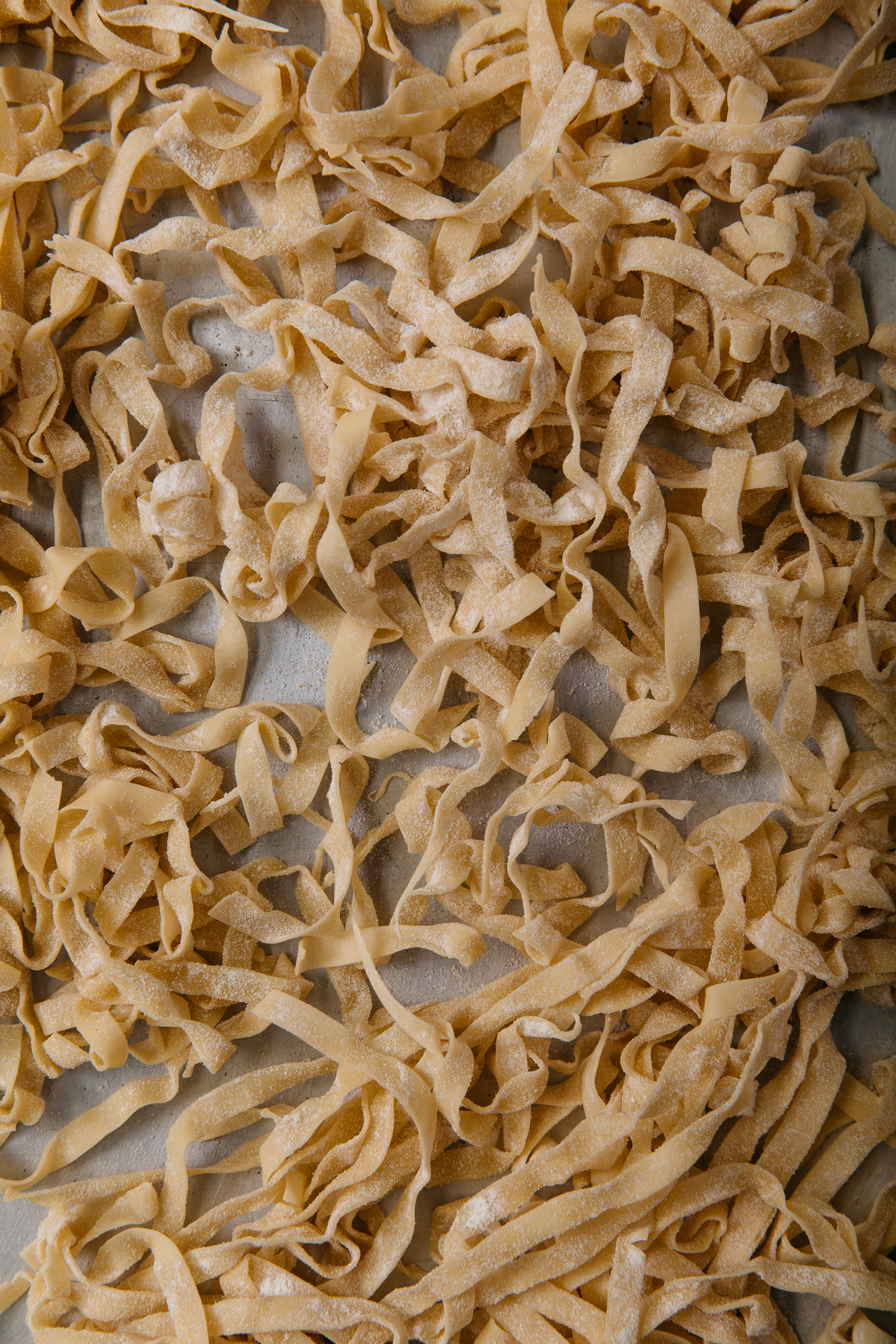Have you ever been to an Italian restaurant and wanted to order pasta, but couldn’t decide which one? I love ordering fresh pasta, especially when I travel to Italy, but I can never decide on the sauce. On a trip to Orvieto a few years ago, a beautiful medieval town not far from Rome, we happened upon a little corner trattoria (I can’t remember the name), bustling full of what seemed to be local diners (always a good sign) that served up fresh pasta like I’ve never seen before. Instead of having to choose one type of pasta, they served up platters of pasta, piled in mounds with different sauces to share.
I would expect to share a whole pizza or platter of antipasti, but as I watched the waiters walk by I couldn’t help gawk at the big platters of fresh pasta, piled in separate mounds dressed with three different sauces and wonder why I had never thought of serving pasta like that before? What a brilliant idea. Because with fresh pasta, why have one when you can try more?
 Now, the idea of having three sauces on the go while you cook pasta is a little daunting, not only do you need to cook the pasta, but there’s three more pots of sauce to manage. But it doesn’t have to be that stressful. These three ‘sauces’ require absolutely no cooking, can be made in advance and simply stirred through the pasta once it’s cooked.
Now, the idea of having three sauces on the go while you cook pasta is a little daunting, not only do you need to cook the pasta, but there’s three more pots of sauce to manage. But it doesn’t have to be that stressful. These three ‘sauces’ require absolutely no cooking, can be made in advance and simply stirred through the pasta once it’s cooked.
They are all pestos, and all you do is mix the ingredients in a food processor until thick and creamy. You can store in the fridge in sealed jars, just pour a little olive oil to create a film over the top prior to sealing to stop discolouration. Then all you have to do is boil the pasta, drain, tip into three bowls, add pesto, stir, scatter with chilli flakes, parmesan and walnuts (not essential but they do add a little oomph) and you’re done.
Obviously you don’t need to make your own pasta to serve a platter of shared pasta, but I think homemade pasta makes this extra special. Making your own pasta is pretty simple, click here to follow my recipe, but if you don’t have time you can buy fresh pasta or use good quality dried fettuccine or pappardelle for a similar effect.
 This is a beautiful way to serve pasta for a crowd. Change the quantities of pasta depending on how many you are serving (as a general rule, 100g pasta will feed 1 person, but I usually cook a little more). The pesto can easily be doubled. Any leftover pesto can be saved for another day, and are all good tossed through any kind of pasta, served with meat or smeared on bread.
This is a beautiful way to serve pasta for a crowd. Change the quantities of pasta depending on how many you are serving (as a general rule, 100g pasta will feed 1 person, but I usually cook a little more). The pesto can easily be doubled. Any leftover pesto can be saved for another day, and are all good tossed through any kind of pasta, served with meat or smeared on bread.
I love the way they look on the plate, red, white and green, the colours of the Italian flag. But what I love most is being able to eat three different varieties of pasta in one meal! Just add a simple salad and crusty bread, and lots of plates to go round.
Fettuccine Three Ways
This recipe is intended to share and feeds 6 people comfortably (although that said, you can never really be sure how much people will eat so I usually cook more than I need – leftovers are always handy the next day). To feed 4 people reduce pasta quantity to 500g.
Ingredients
750g fettuccine (1.5 quantities of pasta dough cut into fettuccine or store-bought)
salt
chilli flakes (to serve)
parmesan cheese, grated (to serve)
50g walnut kernels, toasted and finely chopped (to serve)
WALNUT RICOTTA PESTO
150g walnut kernels, toasted
1 clove garlic, peeled
250g ricotta, drained
3 tbsp parmesan cheese, grated
3 tbsp olive oil
juice of 1/2 a lemon
salt
freshly ground black pepper
CAPSICUM CHILLI PESTO
1 1/2 cups roasted marinated capsicum (store-bought or homemade), drained
30g flaked almonds
1 clove garlic, peeled
small handful fresh basil leaves
1/2 tsp chilli flakes
4 tbsp parmesan cheese, grated
2 tbsp olive oil
salt
BASIL PESTO
1 bunch (approx 1 1/2 cups) fresh basil leaves
1 clove garlic, peeled
30g parmesan cheese, grated
3 tbsp pine nuts
60ml olive oil
1 tsp lemon juice
salt
Method
Start by making the pestos. They can all be made well in advance, spoon into containers or jars, cover the top with a film of olive oil and refrigerate for a week. With all pestos, you are looking for a smooth, thick paste. Drizzle in a little more olive oil than stated if the mixture seems too thick.
Walnut Ricotta Pesto:
Put the walnuts and garlic into the bowl of a food processor and pulse until walnuts are finely chopped. Add the ricotta and parmesan and pulse again to combine. Drizzle in the olive oil and lemon juice and pulse to form a smooth paste. Season with salt and pepper to taste.
Capsicum Chilli Pesto:
Put the capsicum, almonds, garlic, basil, chilli and parmesan into the bowl of a food processor and pulse until smooth. Drizzle in olive oil and pulse to combine until mixture is smooth and creamy. Season with salt to taste.
Basil Pesto:
Put the basil, garlic, parmesan cheese and pine nuts into the bowl of a food processor and pulse until everything is finely chopped. Drizzle in the olive oil and pulse until a smooth paste forms. Stir through the lemon juice and season with salt to taste.
Once the pestos are done and you are ready to serve it is just a matter of cooking the pasta. Using two pots of water to cook the pasta will ensure the fettuccine cooks evenly and doesn’t clump together. If you are reducing the quantities to feed 4 people (this amount feeds 6) one pot will do.
Get two pots of water on the boil and add a generous pinch of salt to each. Add the fettuccine and give a good stir. Cook, stirring every now and then to discourage the fettuccine sticking together, until al dente.
Drain the fettuccine, saving some of the cooking water. Split the fettuccine into three separate bowls. Spoon around 1/2 cup of each pesto into each bowl of fettuccine which a splash of some of the reserved cooking water (around 2 tbsp or so – this loosens the pesto and helps the sauce cling to the pasta) and quickly toss to combine. Add more pesto if you like, there is no rule here.
Get a large plate, pile each variety of fettuccine onto the plate in separate mounds. Sprinkle the walnut pesto fettuccine with walnuts, the capsicum chilli fettuccine with chilli flakes and the basil fettuccine with parmesan (if desired).
Place in the middle of the table with tongs to serve.
Extracted from Liliana’s book: Food For Sharing, Italian Style



Leave a Reply